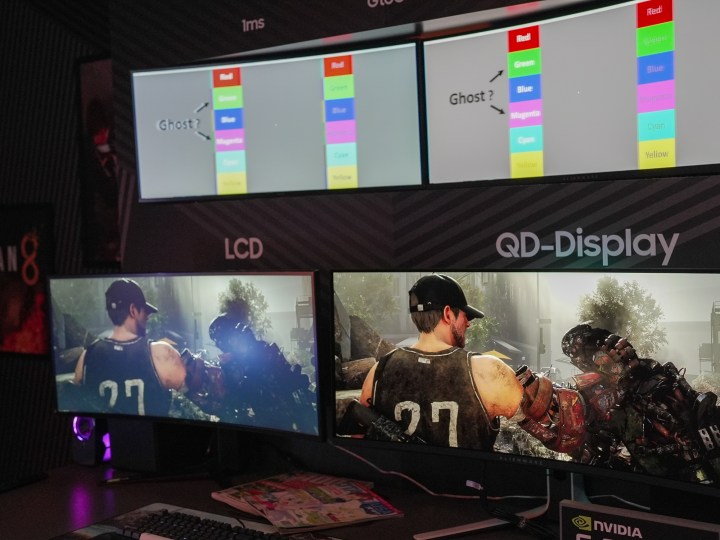I was beginning to think it was the tech unicorn of CES 2022.: A quantum dot OLED display that, by specs and science alone, had the potential to revolutionize TV picture quality. Then I saw it up close, and I’m here to tell you it is the best-looking image I’ve ever seen from a screen. And not by an incremental margin, either. I hate the term “game-changer,” but it absolutely applies here. I couldn’t be more excited for this massive leap forward for TVs in 2022.
How I finally came to see Samsung Display’s QD-OLED (important note: This is not a consumer television from Samsung Electronics) is an adventurous tale unto its own, and one best left for another story. Here, I want to focus on what I saw and why I am convinced that this latest adaptation to OLED display technology is the most exciting thing I’ve seen since the introduction of HDR TVs.

You may have read or watched reports about QD-OLED that were based on technical briefings, but they are full of speculation and educated guesswork. As one of the few TV reviewers who has been fortunate enough to put their eyes on this technology, I’d like to offer some unique perspectives based on both subjective and objective analysis.
QD-OLED isn’t just the usual CES hype — this tech is for real.
What is QD-OLED, again?
To understand what makes QD-OLED different from conventional OLED, it’s important to understand how conventional OLED TVs work.
The OLED panels available on the market today are manufactured by LG Display (like Samsung Display, you can think of LG Display as a separate sister company to LG Electronics) and used by LG, Sony, Panasonic, and several other brands in OLED TVs. They are WRGB OLEDs, which is to say there is a white OLED subpixel (that’s the W in WRGB) used to boost the brightness of red, green, and blue (RGB) OLED pixels. It’s a solution that has worked well for several years now — OLED TVs consistently sit at the top of our list of the best TVs you can buy. But it is not without its drawbacks, and those drawbacks all point back to the use of a color filter and white subpixel.
QD-OLED panels get rid of the white subpixel and color filter entirely by using an all-blue OLED panel with a sheet of printed quantum dots that shine red and green when activated by the blue OLED light. The result is a true RGB display. Without the color filter, overall brightness is increased significantly. And without the white subpixel, the brightness of colors is also significantly boosted.
Other promised benefits to QD-OLED displays are consistent color saturation when viewed off-angle, and significantly reduced potential for burn-in.
In other words, QD-OLED keeps all the advantages of WRGB OLED and mitigates its few (but significant) drawbacks. On paper, this sounds very exciting. But tech reporters have rightfully remained skeptical, pending in-person viewing.

QD-OLED is the truth
After sitting through a short briefing, I was shown Samsung Display’s QD-OLED display, mocked up as a TV. It didn’t have a tuner, smart TV interface, or several other things that make a TV a TV. But the proof of what it is capable of was accurately represented in the demonstration I saw, and it was nothing short of astonishing.
QD-OLED’s higher brightness and superior color saturation has a tremendously dazzling and delightful impact, and the display tech’s ability to show much higher levels of detail in dark, shadowy areas is immediately apparent. What I experienced was a picture with incredible detail, depth, richness, and zeal. It simultaneously was vivid and deep, with an almost 3D-like effect.
Once I calmed my own excitement a bit, I dug a little deeper and noticed that the white light it produced was of much higher purity than the whites I’m used to seeing from WRGB OLED TVs, which tend to have a green tint. That tint isn’t something you notice when watching an OLED TV on its own, but it is impossible not to see it when it sits next to LED TVs and, in this case, the QD-OLED.
Off-angle viewing also was clearly superior. Any degradation in picture quality from well off to the side was difficult to discern without deep scrutiny. And frankly, it probably isn’t something most viewers would notice anyway.
In a separate demonstration, where a 34-inch computer monitor version of the tech was at work, I noted a complete absence of motion blur from quick-scrolling test patterns. This was real-world proof of QD-OLED’s 0.5ms response time for TVs, and 0.1ms response time for computing displays. Text was also significantly sharper than what I’ve seen from conventional OLED displays.
Clearly, QD-OLED is going to be as exciting for gamers as it is for videophiles.

QD-OLED will be here later this year, but it’s going to cost you.
When can you buy QD-OLED?
The good news is that the wait for a QD-OLED TV won’t be long. A representative at Sony informed me the company is targeting a late spring 2022 launch for its Bravia A95K QD-OLED TV. The bad news is that I expect that TV to be extremely expensive.
For its part, Dell’s Alienware gaming division has already shown off a 34-inch widescreen gaming monitor using QD-OLED and promises it is coming soon. Again, I expect that fine piece of hardware to be jaw-droppingly expensive compared to even the most expensive gaming monitors available today.
As for Samsung? Who knows. While Samsung Display makes the technology, Samsung Electronics — which makes the TVs we put in our homes — is remaining tight-lipped with any details around a Samsung-branded QD-OLED TV. I do, however, expect we will have some more information on a Samsung QD-OLED TV (they will probably call it QD-Display, because Samsung) in early March 2022.
For rich people first — then the rest of us
As is often the case with groundbreaking tech, it will be too expensive for most folks when it is first launched, then will come down in price over the course of several years. It may be some time until you or I could hope to own a QD-OLED TV, but just knowing that we can someday have such a stunning picture in our homes one day is a bright future to which I very much look forward.
Editors' Recommendations
- Samsung S95D OLED first look: a reflection on excellence
- Samsung QN900D 8K TV first look: fully loaded flagship
- You Asked: Samsung QD-OLED conundrum, ATSC 3.0, and audio outputs
- Samsung’s new QD-OLED panels get Pantone’s stamp of approval for color accuracy
- Alienware’s new second-gen QD-OLED monitors are stunning




